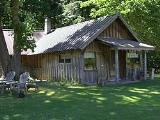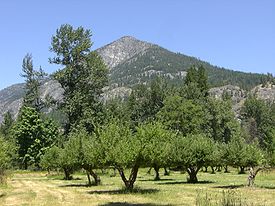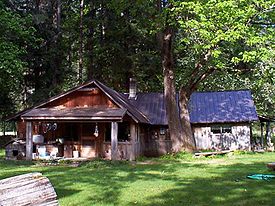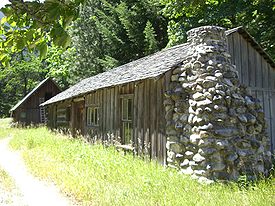
Buckner Homestead Historic District
Encyclopedia
The Buckner Homestead Historic District, near Stehekin, Washington
in Lake Chelan National Recreation Area
incorporates a group of structures relating to the theme of early settlement in the Lake Chelan
area. Representing a time period of over six decades, from 1889 to the 1950s, the district comprises 15 buildings, landscape structures and ruins, and over 50 acres (202,343 m²) of land planted in orchard and criss-crossed by hand-dug irrigation ditches. The oldest building on the farm is a cabin built in 1889. The Buckner family bought the farm in 1910 and remained there until 1970, when the property was sold to the National Park Service
. The Buckner Cabin was listed on the National Register of Historic Places
in 1974. The rest of the Buckner farm became a historic district in 1989. Today, the National Park Service maintains the Buckner homestead and farm as an interpretive center
to give visitors a glimpse at pioneer farm life in the Stehekin Valley.
. When Buzzard arrived in 1889, his 160 acre (0.6474976 km²) parcel was the farthest homestead from the Stehekin settlement at the head of the lake. Buzzard built a one-story log cabin
on the site, and cleared some land for pasture and cultivation. In 1892, Buzzard shipped 1,000 pounds of potatoes 50 miles (80.5 km) down Lake Chelan to the town of Chelan, Washington
and sold the rest of his crop to local miners. By 1895, Buzzard had planted a small apple
orchard
and was growing cabbages as well as potatoes. Buzzard also cut cordwood on his property and sold it to the steamboat
company that operated on Lake Chelan. According to a 1902 United States Forest Service
report on "agricultural settlement" in the Stehekin area, William Buzzard had a three-room house, log barn, and 25 acres (101,171.5 m²) of cultivated land. On 9 November 1903, Buzzard officially purchased his homestead from the United States Government. He later sold 11 acres (44,515.5 m²) to a neighbor.
n named William Buckner for $5,000. Instead of a lump-sum payment, Buzzard wanted $50 per month until the total amount was paid. After selling the property, Buzzard moved to Chelan where he lived until his death in 1919. When Buzzard died, Buckner was only one payment short of completing the agreement so he used the final $50 payment to purchase a headstone
for Buzzard, who was buried in the Old Fraternal Cemetery in Chelan.
 In 1911, Buckner brought his wife and three sons to the farm (also call the “Buckner ranch”). Upon arrival, the family found most of the land covered with stumps because the timber had been cut and sold by the previous owner. Over the next several years, the family cleared enough stumps to plant a 50 acres (202,343 m²) apple orchard. The Buckners also designed an irrigation
In 1911, Buckner brought his wife and three sons to the farm (also call the “Buckner ranch”). Upon arrival, the family found most of the land covered with stumps because the timber had been cut and sold by the previous owner. Over the next several years, the family cleared enough stumps to plant a 50 acres (202,343 m²) apple orchard. The Buckners also designed an irrigation
system that diverted water from Rainbow Creek to their orchard. The main irrigation canal and watering ditches, totaling over four miles (6 km), were all dug by hand during the summer of 1911.
Initially, the Buckner family only lived on the ranch during the summer, moving back to California
in the fall to avoid Stehekin’s harsh winters. However the family returned each spring to work their farm. Over the next few years, they constructed a variety of buildings for protecting animals, sheltering farm equipment, and preserving food. Eventually, the Buckner ranch had more than a dozen structures including a barn
, workshop, milk house, smokehouse
, root cellar, chicken coop, outhouse
, sleeping cabins for guests or hired hands, and several general-purpose sheds. They also built a mile of wooden fence to enclose their entire property.
 In 1915, Harry Buckner, one of William’s sons, took up permanent residence at the ranch. In 1919, Harry married a young lady from Stehekin and she joined him at the ranch. Since William Buckner and his wife continued to live in Bill Buzzard’s log cabin during the summer months until 1924, Harry expanded one of sleeping cabins into a home for himself and his new wife, Olive. Harry and Olive worked hard to make the farm a comfortable place to live. They raised pigs, cows and chickens. The family grew vegetables in their garden, and planted large flower beds. When the family decided they wanted electric lights, Harry converted a smokehouse into a power generator house. Harry also built a play house for his three young daughters; and when the girls were older, he constructed a concrete swimming pool
In 1915, Harry Buckner, one of William’s sons, took up permanent residence at the ranch. In 1919, Harry married a young lady from Stehekin and she joined him at the ranch. Since William Buckner and his wife continued to live in Bill Buzzard’s log cabin during the summer months until 1924, Harry expanded one of sleeping cabins into a home for himself and his new wife, Olive. Harry and Olive worked hard to make the farm a comfortable place to live. They raised pigs, cows and chickens. The family grew vegetables in their garden, and planted large flower beds. When the family decided they wanted electric lights, Harry converted a smokehouse into a power generator house. Harry also built a play house for his three young daughters; and when the girls were older, he constructed a concrete swimming pool
, feed by farm’s irrigation system.
In 1922, the Buckners built a large packing shed to protect their apple harvest. In the 1930s and 1940s, the farm produced between 4,000 and 5,000 crates of apple each season. That was enough fruit to fill their 40 feet (12.2 m) by 100 feet (30.5 m) packing shed. This was the peak of the farm’s production.
Olive Buckner died in 1948. Harry continued to live on the ranch and eventually remarried. In 1953, the packing shed roof collapsed under a heavy winter snow load. In 1956, Buckner retired from farming and became Stehekin’s postmaster
. In 1970, Buckner sold the homestead and most of his property to the National Park Service, retaining a parcel of land for his retirement home. He lived there until his death in 1976.
to show visitors what pioneer life was like in the Stehekin Valley. Although it is no longer a commercial farm, horses still graze in the Buckner’s pasture, water still flows through the irrigation ditches, and apples are still harvested from the orchard in the fall. While some changes have been made to the building in order to preserve them, many of the structures are still in use for their intended purpose, including the main house which is now home for a National Park Service employee.
Because of its unique historic value as an original settler’s homestead, the Buckner Cabin (originally built by William Buzzard) was listed on the National Register of Historic Places in 1974 (NRHP #74000912). In 1989, the remaining elements of the Buckner farm were joined with the cabin to create the Buckner Homestead Historic District.

Other buildings on the Buckner farm include a sleeping house, tool and equipment sheds, root cellar, chicken coops, outhouse, and a children’s play house. The Buckner’s swimming pool is included on the National Park Services inventory of structures, however, it is kept empty for safety reasons. Old farm equipment, like the Buckner's 1911 Hercules Stump Puller and several farm trucks, are also on display. The National Park Service maintains the Buckner’s orchard, harvesting its apples every fall.
Stehekin, Washington
Stehekin is a small unincorporated community in Chelan County, Washington. It is part of Wenatchee–East Wenatchee Metropolitan Statistical Area. Located at the northwest end of Lake Chelan, it lies just south of the North Cascades National Park at . It is within Lake Chelan National...
in Lake Chelan National Recreation Area
Lake Chelan National Recreation Area
Lake Chelan National Recreation Area is a U.S. National Recreation Area located about south of the Canadian border in Chelan County, Washington. It encompasses an area of approximately including the northern end of Lake Chelan and the surrounding area of the Stehekin Valley and the Stehekin...
incorporates a group of structures relating to the theme of early settlement in the Lake Chelan
Lake Chelan
Lake Chelan is a narrow, 55-mile-long lake in Chelan County, northern Washington state, U.S. It is the largest natural lake in Washington state...
area. Representing a time period of over six decades, from 1889 to the 1950s, the district comprises 15 buildings, landscape structures and ruins, and over 50 acres (202,343 m²) of land planted in orchard and criss-crossed by hand-dug irrigation ditches. The oldest building on the farm is a cabin built in 1889. The Buckner family bought the farm in 1910 and remained there until 1970, when the property was sold to the National Park Service
National Park Service
The National Park Service is the U.S. federal agency that manages all national parks, many national monuments, and other conservation and historical properties with various title designations...
. The Buckner Cabin was listed on the National Register of Historic Places
National Register of Historic Places
The National Register of Historic Places is the United States government's official list of districts, sites, buildings, structures, and objects deemed worthy of preservation...
in 1974. The rest of the Buckner farm became a historic district in 1989. Today, the National Park Service maintains the Buckner homestead and farm as an interpretive center
Heritage interpretation
Heritage interpretation is the communication of information about, or the explanation of, the nature, origin, and purpose of historical, natural, or cultural resources, objects, sites and phenomena using personal or non-personal methods....
to give visitors a glimpse at pioneer farm life in the Stehekin Valley.
Bill Buzzard
The property that became the Buckner farm was originally settled by William (Bill) Buzzard. It is located several miles north of Lake Chelan along the Stehekin RiverStehekin River
The Stehekin River is a river located in Washington state in the Pacific Northwest of the United States. It is the main river flowing into Lake Chelan. Miners arrived in Stehekin River Valley in the late 19th century. They were followed by homesteaders in the early 20th century...
. When Buzzard arrived in 1889, his 160 acre (0.6474976 km²) parcel was the farthest homestead from the Stehekin settlement at the head of the lake. Buzzard built a one-story log cabin
Log cabin
A log cabin is a house built from logs. It is a fairly simple type of log house. A distinction should be drawn between the traditional meanings of "log cabin" and "log house." Historically most "Log cabins" were a simple one- or 1½-story structures, somewhat impermanent, and less finished or less...
on the site, and cleared some land for pasture and cultivation. In 1892, Buzzard shipped 1,000 pounds of potatoes 50 miles (80.5 km) down Lake Chelan to the town of Chelan, Washington
Chelan, Washington
Chelan is a city in Chelan County, Washington, United States. The population was 3,890 at the 2010 census. It sits on the southeast tip of Lake Chelan, where the lake flows into the Chelan River....
and sold the rest of his crop to local miners. By 1895, Buzzard had planted a small apple
Apple
The apple is the pomaceous fruit of the apple tree, species Malus domestica in the rose family . It is one of the most widely cultivated tree fruits, and the most widely known of the many members of genus Malus that are used by humans. Apple grow on small, deciduous trees that blossom in the spring...
orchard
Orchard
An orchard is an intentional planting of trees or shrubs that is maintained for food production. Orchards comprise fruit or nut-producing trees which are grown for commercial production. Orchards are also sometimes a feature of large gardens, where they serve an aesthetic as well as a productive...
and was growing cabbages as well as potatoes. Buzzard also cut cordwood on his property and sold it to the steamboat
Steamboat
A steamboat or steamship, sometimes called a steamer, is a ship in which the primary method of propulsion is steam power, typically driving propellers or paddlewheels...
company that operated on Lake Chelan. According to a 1902 United States Forest Service
United States Forest Service
The United States Forest Service is an agency of the United States Department of Agriculture that administers the nation's 155 national forests and 20 national grasslands, which encompass...
report on "agricultural settlement" in the Stehekin area, William Buzzard had a three-room house, log barn, and 25 acres (101,171.5 m²) of cultivated land. On 9 November 1903, Buzzard officially purchased his homestead from the United States Government. He later sold 11 acres (44,515.5 m²) to a neighbor.
Buckner family
In 1910, Buzzard sold his remaining property to a CaliforniaCalifornia
California is a state located on the West Coast of the United States. It is by far the most populous U.S. state, and the third-largest by land area...
n named William Buckner for $5,000. Instead of a lump-sum payment, Buzzard wanted $50 per month until the total amount was paid. After selling the property, Buzzard moved to Chelan where he lived until his death in 1919. When Buzzard died, Buckner was only one payment short of completing the agreement so he used the final $50 payment to purchase a headstone
Headstone
A headstone, tombstone, or gravestone is a marker, usually stone, that is placed over a grave. In most cases they have the deceased's name, date of birth, and date of death inscribed on them, along with a personal message, or prayer.- Use :...
for Buzzard, who was buried in the Old Fraternal Cemetery in Chelan.

Surface irrigation
Surface irrigation is defined as the group of application techniques where water is applied and distributed over the soil surface by gravity. It is by far the most common form of irrigation throughout the world and has been practiced in many areas virtually unchanged for thousands of years.Surface...
system that diverted water from Rainbow Creek to their orchard. The main irrigation canal and watering ditches, totaling over four miles (6 km), were all dug by hand during the summer of 1911.
Initially, the Buckner family only lived on the ranch during the summer, moving back to California
California
California is a state located on the West Coast of the United States. It is by far the most populous U.S. state, and the third-largest by land area...
in the fall to avoid Stehekin’s harsh winters. However the family returned each spring to work their farm. Over the next few years, they constructed a variety of buildings for protecting animals, sheltering farm equipment, and preserving food. Eventually, the Buckner ranch had more than a dozen structures including a barn
Barn
A barn is an agricultural building used for storage and as a covered workplace. It may sometimes be used to house livestock or to store farming vehicles and equipment...
, workshop, milk house, smokehouse
Smokehouse
A smokehouse is a building where meat or fish is cured with smoke. The finished product might be stored in the building, sometimes for a year or more.-History:...
, root cellar, chicken coop, outhouse
Outhouse
An outhouse is a small structure separate from a main building which often contained a simple toilet and may possibly also be used for housing animals and storage.- Terminology :...
, sleeping cabins for guests or hired hands, and several general-purpose sheds. They also built a mile of wooden fence to enclose their entire property.

Swimming pool
A swimming pool, swimming bath, wading pool, or simply a pool, is a container filled with water intended for swimming or water-based recreation. There are many standard sizes; the largest is the Olympic-size swimming pool...
, feed by farm’s irrigation system.
In 1922, the Buckners built a large packing shed to protect their apple harvest. In the 1930s and 1940s, the farm produced between 4,000 and 5,000 crates of apple each season. That was enough fruit to fill their 40 feet (12.2 m) by 100 feet (30.5 m) packing shed. This was the peak of the farm’s production.
Olive Buckner died in 1948. Harry continued to live on the ranch and eventually remarried. In 1953, the packing shed roof collapsed under a heavy winter snow load. In 1956, Buckner retired from farming and became Stehekin’s postmaster
Postmaster
A postmaster is the head of an individual post office. Postmistress is not used anymore in the United States, as the "master" component of the word refers to a person of authority and has no gender quality...
. In 1970, Buckner sold the homestead and most of his property to the National Park Service, retaining a parcel of land for his retirement home. He lived there until his death in 1976.
National Park Service
After purchasing the Buckner property, the National Park Service incorporated it into the Lake Chelan National Recreation Area. The Buckner homestead and farm has been preserved, and is used by the National Park Service as an interpretive centerHeritage interpretation
Heritage interpretation is the communication of information about, or the explanation of, the nature, origin, and purpose of historical, natural, or cultural resources, objects, sites and phenomena using personal or non-personal methods....
to show visitors what pioneer life was like in the Stehekin Valley. Although it is no longer a commercial farm, horses still graze in the Buckner’s pasture, water still flows through the irrigation ditches, and apples are still harvested from the orchard in the fall. While some changes have been made to the building in order to preserve them, many of the structures are still in use for their intended purpose, including the main house which is now home for a National Park Service employee.
Because of its unique historic value as an original settler’s homestead, the Buckner Cabin (originally built by William Buzzard) was listed on the National Register of Historic Places in 1974 (NRHP #74000912). In 1989, the remaining elements of the Buckner farm were joined with the cabin to create the Buckner Homestead Historic District.
Historic structures
The Buckner Homestead Historic District comprises 15 buildings, various landscape features, some old structural ruins, and approximately 50 acres (202,343 m²) of apple orchard which is irrigated by hand-dug ditches.
- The original William Buzzard Cabin was built in 1889. It was a one-story log cabin measuring 16 feet (4.9 m) by 18 feet (5.5 m). In 1910, Buzzard added over 23 feet (7 m) to the length of the cabin, making it 16 feet (4.9 m) by 42 feet (12.8 m). After purchasing the homestead, Buckner added a massive river-stone fireplaceFireplaceA fireplace is an architectural structure to contain a fire for heating and, especially historically, for cooking. A fire is contained in a firebox or firepit; a chimney or other flue allows gas and particulate exhaust to escape...
and chimney in 1911. The cabin has a stone and concrete floor, log walls, and a wood shakeShake (shingle)A shake is a basic wooden shingle that is made from split logs. Shakes have traditionally been used for roofing and siding applications around the world. Higher grade shakes are typically used for roofing purposes, while the lower grades are used for siding purposes...
roof. The Buckner’s used the cabin as a primary residence until 1924, when it became a guest house. The National Park Service renovated the cabin in 1980, and stabilized the structure in 1999. The cabin is listed on the National Register of Historic Places as the Buckner Cabin.
- The Buckner homestead’s main residence was originally built in 1914 as a 12 feet (3.7 m) by 18 feet (5.5 m) summer sleeping cabin. The Buckner family added a 16 feet (4.9 m) by 18 feet (5.5 m) living room in 1915, and another bedroom and a large fireplace in 1921. A third bedroom and a kitchen were added in 1925. The National Park Service added a porch in 1983, and re-roofed the house 1975 and again in 1999. It is a wood-frame house on a stone and concrete foundation; the walls are weatherboard, and it has a metal roof.
- The Buckner homestead hayHayHay is grass, legumes or other herbaceous plants that have been cut, dried, and stored for use as animal fodder, particularly for grazing livestock such as cattle, horses, goats, and sheep. Hay is also fed to pets such as rabbits and guinea pigs...
barn and workshop was built in 1949. It is a two-story building with a large hay loft and gable roof. The building’s footprint measures 21 feet (6.4 m) by 24 feet (7.3 m). It is a wood-frame structure on a concrete foundation with weatherboard siding and a metal roof. The main entrance is a large wood-panel sliding door on the north side of the building.
- The Buckner’s Milk House was built in 1916. It is a 6 feet (1.8 m) by 8 feet (2.4 m) one-story, wood-frame structure on a raised concrete foundation with an overhanging gable roof. The National Park Service rehabilitated the building in 1979.
- The "Delco House" provided electricity for the farm. Originally, built as a smokehouse in 1915, it was converted to house the Delco power generator in 1925. It is a one-story, wood-frame structure on a 4 feet (1.2 m) by 8 feet (2.4 m) concrete foundation. The building has weatherboard siding and a wooden shake roof.
- The farm’s wood and harnessHorse harnessA horse harness is a type of horse tack that allows a horse or other equine to pull various horse-drawn vehicles such as a carriage, wagon or sleigh. Harnesses may also be used to hitch animals to other loads such as a plow or canal boat....
shed was built in 1950. It is a one-story, log-frame structure on a concrete foundation with a wooden gabled roof. The building measure 12 feet (3.7 m) by 20 feet (6.1 m). The National Park Service replaced the shed roof in 1980, and accomplished addition preservation work in 2005.
Other buildings on the Buckner farm include a sleeping house, tool and equipment sheds, root cellar, chicken coops, outhouse, and a children’s play house. The Buckner’s swimming pool is included on the National Park Services inventory of structures, however, it is kept empty for safety reasons. Old farm equipment, like the Buckner's 1911 Hercules Stump Puller and several farm trucks, are also on display. The National Park Service maintains the Buckner’s orchard, harvesting its apples every fall.
External links
- North Cascades National Park Complex - National Park Service
- Buckner Homestead Heritage Foundation

